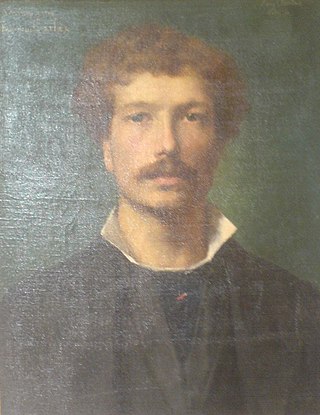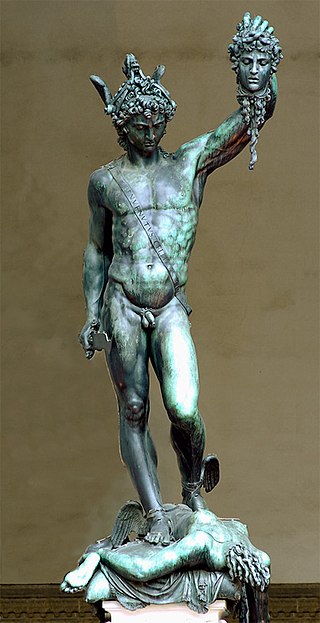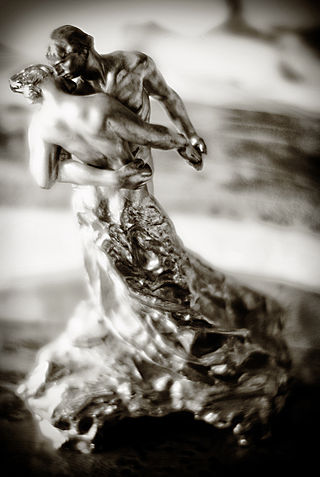
François Auguste René Rodin was a French sculptor, generally considered the founder of modern sculpture. He was schooled traditionally and took a craftsman-like approach to his work. Rodin possessed a unique ability to model a complex, turbulent, and deeply pocketed surface in clay. He is known for such sculptures as The Thinker, Monument to Balzac, The Kiss, The Burghers of Calais, and The Gates of Hell.

Camille Rosalie Claudel was a French sculptor known for her figurative works in bronze and marble. She died in relative obscurity, but later gained recognition for the originality and quality of her work. The subject of several biographies and films, Claudel is well known for her sculptures including The Waltz and The Mature Age.

Paul Dubois was a French sculptor and painter from Nogent-sur-Seine. His works were mainly sculptures and statues, and he was also a portrait painter.

Camille Claudel is a 1988 French biographical drama film about the life of 19th-century sculptor Camille Claudel. The film was based on the book by Reine-Marie Paris, granddaughter of Camille's brother, the poet and diplomat Paul Claudel. It was directed by Bruno Nuytten, co-produced by Isabelle Adjani, and starred her and Gérard Depardieu. The film had a total of 2,717,136 admissions in France. Adjani was nominated for the Academy Award for Best Actress for her role, the second in her career.

The Musée Rodin in Paris, France, is an art museum that was opened in 1919, primarily dedicated to the works of the French sculptor Auguste Rodin. It has two sites: the Hôtel Biron and surrounding grounds in central Paris, as well as just outside Paris at Rodin's old home, the Villa des Brillants at Meudon, Hauts-de-Seine. The collection includes 6,600 sculptures, 8,000 drawings, 8,000 old photographs and 7,000 objets d'art. The museum receives 700,000 visitors annually.

Alfred Boucher was a French sculptor who was a mentor to Camille Claudel and a friend of Auguste Rodin.

Nogent-sur-Seine is a commune in the Aube department in north-central France. The headquarters of The Soufflet Group is located here, as is the Musée Camille Claudel. The large Nogent Nuclear Power Plant is located here.

Volubilis ("intertwined") is a series of marble sculptures by French sculptor Alfred Boucher (1850–1934), mentor to Camille Claudel and friend of Auguste Rodin.

Jean-Antonin Carles was a French sculptor.

The Mature Age, also named Destiny, The Path of Life or Fatality (1894–1900) is a sculpture by French artist Camille Claudel. The work was commissioned by the French government in 1895, but the commission was cancelled in 1899 before a bronze was cast. A plaster version of the sculpture was exhibited in 1899, and then cast in bronze privately in 1902. A second private bronze casting was made in 1913, and it is thought that the plaster version was destroyed at that time.

Perseus with the Head of Medusa is a bronze sculpture made by Benvenuto Cellini in the period 1545–1554. The sculpture stands on a square base which has bronze relief panels depicting the story of Perseus and Andromeda, similar to a predella on an altarpiece. It is located in the Loggia dei Lanzi in the Piazza della Signoria in Florence, Italy. The second Florentine duke, Duke Cosimo I de' Medici, commissioned the work with specific political connections to the other sculptural works in the piazza. When the piece was revealed to the public on 27 April 1554, Michelangelo's David, Bandinelli's Hercules and Cacus, and Donatello's Judith and Holofernes were already installed in the piazza.

Jean Turcan was a French sculptor who specialized particularly in public figures.

Eternal Springtime is a c. 1884 sculpture by the French artist Auguste Rodin, depicting a pair of lovers. It was created at the same time as The Gates of Hell and originally intended to be part of it. One of its rare 19th-century original casts belongs to the permanent collection of Calouste Gulbenkian Museum.

The Waltz or The Waltzers is a sculpture by French artist Camille Claudel. It depicts two figures, a man and a woman, locked in an amorous embrace as they dance a waltz. The work was inspired by Claudel's burgeoning love affair with her mentor and employer Auguste Rodin. Various versions were made from 1889 to 1905, initially modelled in plaster, and later cast in bronze. Examples are held by the Musée Rodin and the Musée Camille Claudel.

The Musée Camille Claudel is a French national museum which honors and exhibits the art of sculptor Camille Claudel. The museum displays approximately half of Claudel's existing artwork. The Claudel museum was opened in 2017 in her teenage home town of Nogent-sur-Seine, 100 kilometers southeast of Paris.

The Bust of Auguste Rodin was sculpted by the French artist Camille Claudel in 1888-1889 as a tribute to her teacher and lover, Auguste Rodin.

Sakuntala, also known as Sakountala or Çacountala, is a sculpture by the French artist Camille Claudel, made in several versions in different media from 1886, with a marble version completed in 1905, and bronze castings made from 1905. The sculpture depicts a young couple, with a kneeling man embracing a woman leaning towards him. It was named after the play Shakuntala by the 4th-5th century Indian poet Kālidāsa, and is inspired by the moment when the title character Shakuntala is reunited with her husband Dushyanta after a long separation.

Rose Beuret (born Marie Rose Beuret; 9 June, 1844 in Vecqueville and died on 14 February, 1917 in Meudon, was a French seamstress and laundress, known to have been one of the muses and, for 53 years, the companion of Auguste Rodin, whom she married just weeks before her death in 1917.


















